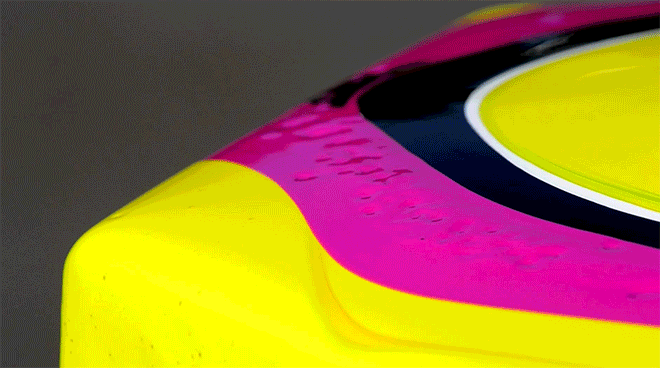With so many people broadcasting their feelings on social media, we're reaching a point where we can reasonably say we're able to discern the mood of a city at a given moment. A group of artists in Oslo came up with a striking way of visualizing that emerging data set: a tiny monolith that oozes different colors of paint depending on the tweets published around it.
"Monolitt" was created by Syver Lauritzsen and Eirik Haugen Murvoll, a pair of students at the Oslo School of Architecture and Design. From the start, the duo was captivated by the idea of representing social media, a very new phenomenon, with paint, one of our most enduring materials. But arriving at the final design involved some experimentation.
First, they played around with paintballs, which were nice and visceral, but ultimately too modern to achieve the contrast the duo was hoping for (when you think about it, is there any more Twitter-like way to apply paint than paintballs?) Eventually, they came across the work of an artist named Holton Rower, whose three-dimensional paintings, made by pouring layers of paint over various shapes, served as inspiration for their oozing tower.
The installation relies on software that applies keyword-spotting sentiment analysis to tweets in the Oslo area. "Usually you’ll see these as graphs, with the x-axis going from negative to positive, and the y-axis going from calm to excited," Lauritzsen says. "By overlaying appropriate colors over this graph, tweets could determine what color the sculpture would release."
For the prototype shown in the video above (filmed by their friend Liam Teal, with music by Einar Stabenfeldt), the duo experimented with a handful of different color assignments and tried a few approaches to how those colors were actually triggered. In some tests, they programmed the sculpture to spew paint for each new tweet. In others, they had it dispense color less frequently to reflect the general mood over a period of time. "As we found through experimentation, the latter looks prettier, but probably isn’t as functional as the first," Lauritzsen says.
In every case, it's a more interesting way to glean the mood of the public than scrolling through a Twitter timeline. "It’s absolutely hypnotic watching the colors swirl and mix together before your eyes," Lauritzsen says. As the paint drips down the monument, it effectively becomes a record of how the city feels, a document in which one might be to discern periods of calm or agitation, not unlike a tree's rings.
Of course, Lauritzsen and Murvoll's waist-high monument can only display so much before the paint gets muddled. That's one place where the prototype didn't quite live up to their initial vision for the piece. "In an ideal world we would like it to be three or four times larger," Lauritzsen says. "Like a proper monolith."

